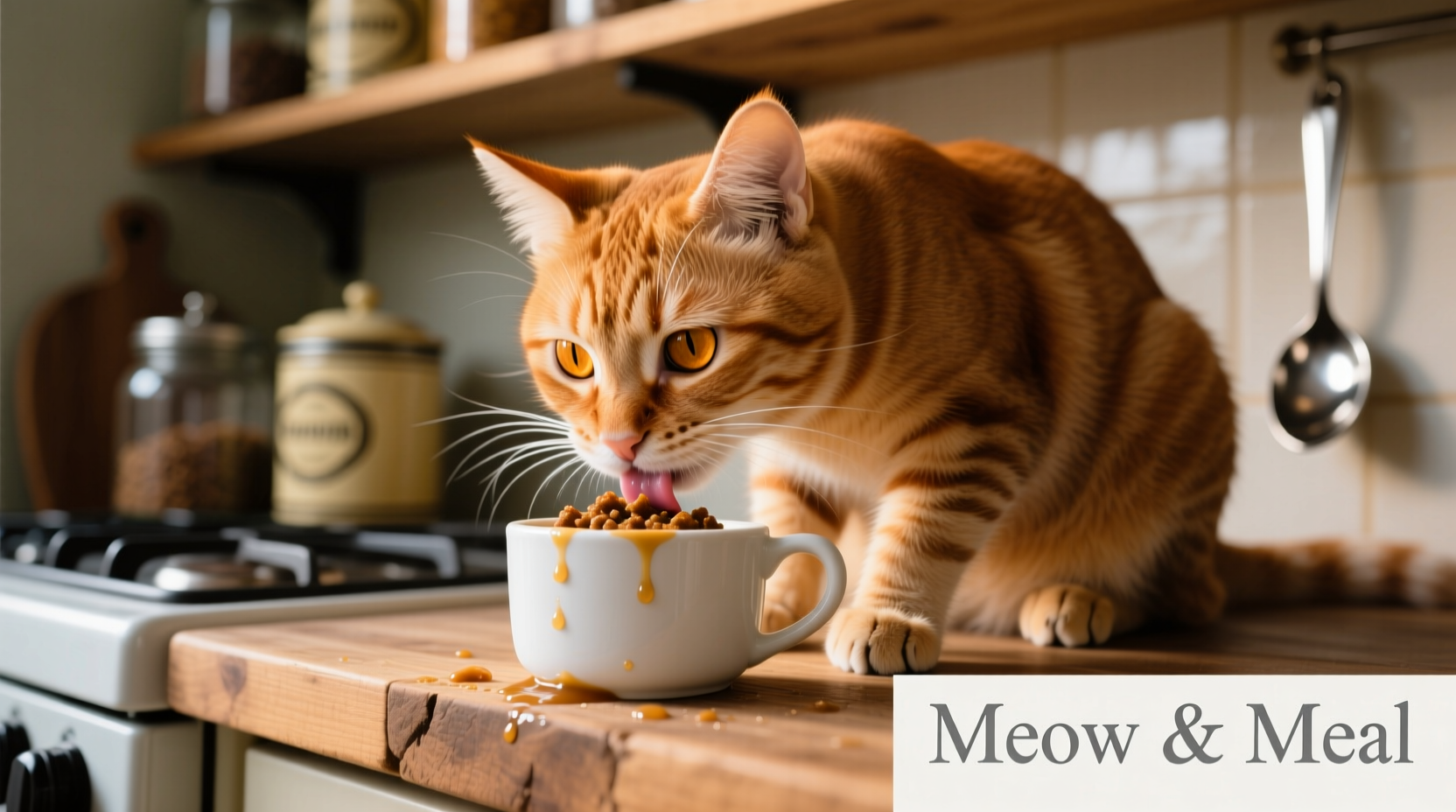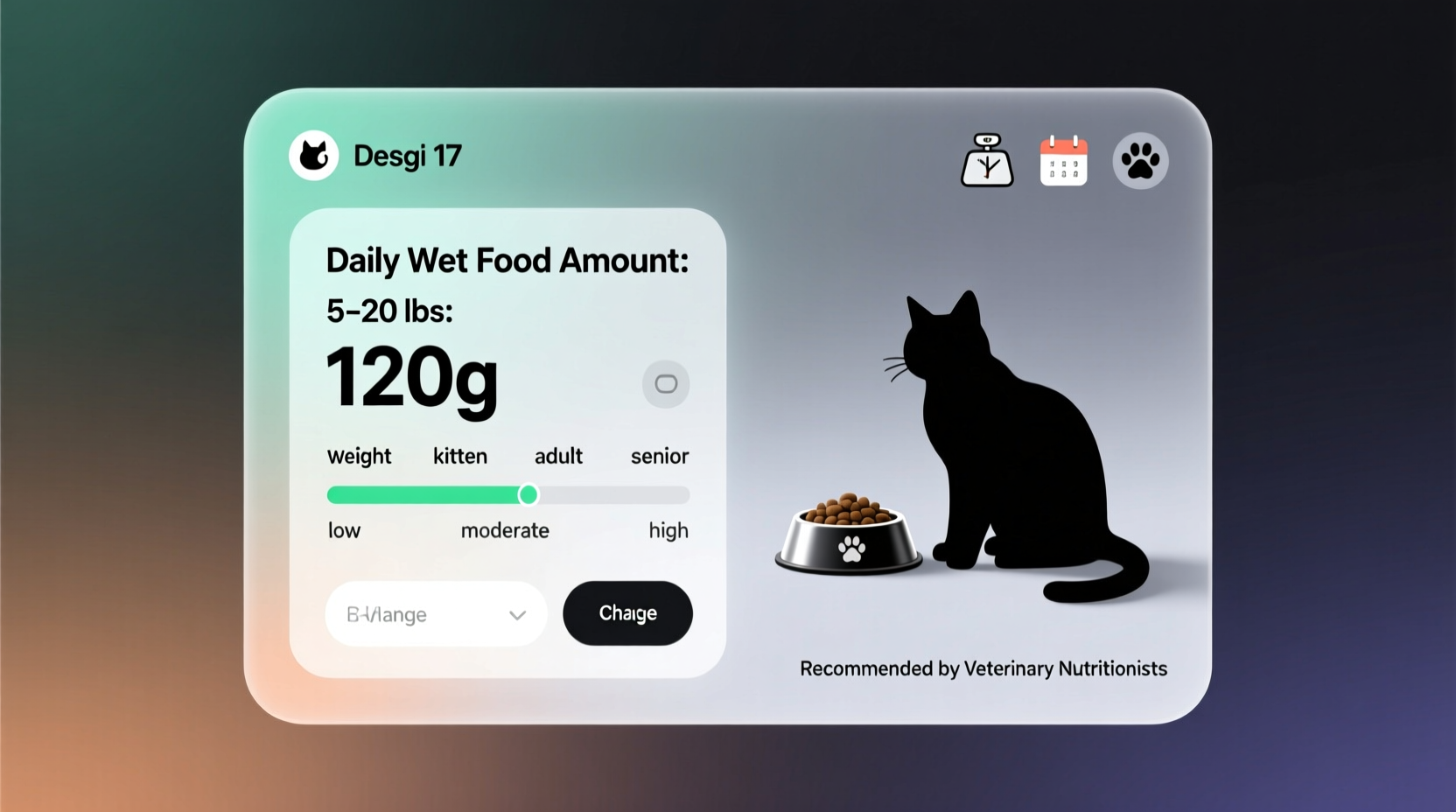Getting your cat's wet food portions right is crucial for their health and longevity. Too little can lead to malnutrition, while too much contributes to obesity—a condition affecting over 60% of household cats according to the Association for Pet Obesity Prevention. This guide provides a scientifically grounded method to calculate precise wet food portions for your feline companion.
Your Step-by-Step Wet Food Calculator
Unlike generic online tools, this calculator considers all critical factors affecting your cat's nutritional needs. Follow these steps to determine the perfect portion:
Step 1: Determine Your Cat's Calorie Requirements
Most healthy adult cats need 20-30 calories per pound of body weight daily. Kittens, seniors, and special health cases require different calculations:
| Cat Category | Calories Per Pound | Daily Total (8lb Cat) |
|---|---|---|
| Adult Maintenance | 20-25 | 160-200 |
| Active Adult | 25-30 | 200-240 |
| Kitten (3-12 mos) | 30-35 | 240-280 |
| Senior (7+ years) | 18-22 | 145-175 |
This calorie framework aligns with AAFCO guidelines and veterinary nutrition standards. The National Research Council confirms these ranges provide optimal energy balance for most cats.
Step 2: Check Your Food's Calorie Density
Wet cat foods vary significantly in calorie concentration. Locate the kcal/kg or kcal/can information on the label:
- Standard pâté: ~1,000 kcal/kg (about 70-100 kcal per 3oz can)
- Gravy formulas: ~900 kcal/kg (about 60-80 kcal per 3oz can)
- High-protein varieties: ~1,200 kcal/kg (about 85-110 kcal per 3oz can)

Step 3: Calculate Your Cat's Daily Portion
Use this formula:
Daily ounces = (Daily calorie needs ÷ Food's kcal per ounce)
Example for 10lb adult cat needing 220 calories:
If food provides 35 calories per ounce (typical 3oz can with 105 kcal):
220 ÷ 35 = 6.3 ounces daily
Factors That Change Standard Calculations
Several conditions require portion adjustments beyond basic weight calculations:
Health Conditions Requiring Veterinary Guidance
Certain medical issues dramatically alter nutritional needs:
- Diabetes: Requires consistent carbohydrate-controlled portions (typically 1/2 can less than standard)
- Kidney disease: Needs phosphorus-restricted diets with adjusted protein levels
- Obesity: Requires 15-20% calorie reduction with gradual weight loss monitoring
- Hyperthyroidism: Often needs 25-30% more calories due to increased metabolism
The American Animal Hospital Association emphasizes that cats with chronic conditions need individualized feeding plans developed with veterinary nutritionists.
Life Stage Adjustments
Nutritional needs evolve throughout a cat's life:
| Life Stage | Key Nutritional Focus | Portion Adjustment |
|---|---|---|
| Kittens (0-12 mos) | Higher protein, DHA for brain development | 2.5x adult maintenance calories |
| Prime Adult (1-6 yrs) | Balanced nutrition for optimal health | Standard maintenance portions |
| Mature (7-10 yrs) | Easier digestion, joint support | 10-15% less than adult portions |
| Senior (11+ yrs) | Renal support, maintain muscle mass | Higher protein, adjusted calories |
Avoid These Common Feeding Mistakes
Even with proper calculations, these errors undermine your efforts:
Mistake 1: Ignoring Treat Calories
Treats should never exceed 10% of daily calories. A single 10-calorie treat for an 8lb cat equals nearly 1/6 of their daily needs. Track all supplemental calories using apps like MyFitnessPal adapted for pet nutrition.
Mistake 2: Free-Feeding Wet Food
Unlike dry food, wet food spoils quickly at room temperature. Bacteria growth begins within 4 hours, potentially causing digestive issues. The 2023 Feline Nutrition Survey found cats free-fed wet food had 23% higher incidence of gastrointestinal problems.
Mistake 3: Inconsistent Feeding Schedules
Cats thrive on routine. Irregular meal times disrupt their metabolism and can cause anxiety-related overeating. Aim for consistent intervals—typically every 8-12 hours for adults.
When to Consult Your Veterinarian
While this calculator works for healthy cats, seek professional guidance when:
- Your cat loses or gains more than 10% of body weight in 30 days
- You notice changes in eating habits lasting over 48 hours
- Your senior cat shows decreased appetite or muscle wasting
- You're transitioning between food types or life stages
Veterinary nutritionists can perform body condition scoring and create customized feeding plans. The American College of Veterinary Nutrition reports that professionally guided feeding plans improve health outcomes by 37% compared to owner-calculated portions.
Practical Implementation Tips
Make accurate feeding part of your routine:
- Invest in a kitchen scale: Eyeballing portions creates 20-30% variance. Digital scales measuring in 0.1oz increments ensure precision.
- Pre-portion meals: Divide daily food into containers the night before for consistent morning/evening servings.
- Track weight weekly: Weigh your cat on the same day/time using a baby scale to monitor trends.
- Adjust seasonally: Indoor cats may need 5-10% fewer calories in summer when less active.
Remember that optimal feeding combines precise measurement with attentive observation of your cat's body condition and energy levels. The perfect portion keeps ribs palpable but not visible, with a visible waistline when viewed from above.











 浙公网安备
33010002000092号
浙公网安备
33010002000092号 浙B2-20120091-4
浙B2-20120091-4